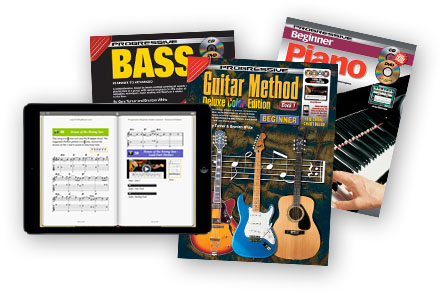<< First < Previous | Intro 1 2 3 4 5 | Next > Last >>
Back to Table of Contents
| 9 | (Fingers) |
Video
| 10 | (Fingers) |
Video
| 10 | (Pick) |
Video
| 11 | (Fingers) |
Video
| 11 | (Pick) |
Video
Alternate Picking
If you have been playing the examples using your right hand fingers, you have been alternating i, m, i, m, etc or m, i, m, i, etc. This applies whether the note is a quarter note, a half note or an eighth note. If you have been using a pick, all of the examples you have so far played involved a downward motion, indicated by a  . With the introduction of eighth notes, the technique of down and up (
. With the introduction of eighth notes, the technique of down and up (  ) picking is used. This is called alternate picking, and it is essential for the development of speed and accuracy.
) picking is used. This is called alternate picking, and it is essential for the development of speed and accuracy.
Alternate pick motion – 







In alternate picking, use a down pick on the beat (the number count) and an up pick off the beat (the ‘and’ count). Apply alternate picking to the previous two examples. As a general rule play eighth notes using alternate picking.
| 12 | 12 Bar Blues in the Key of G Major |
The following progression is a 12 Bar Blues in the key of G. End this 12 bar progression by playing a G note.
Instead of writing a chord symbol over every bar of music it is common to only use the symbol when there is a new chord, e.g., the first four bars of this Blues are a G chord.
| 12 | (Fingers) |
Video
| 12 | (Pick) |
Video
| 13 |
The following example is a 12 Bar Blues in the key of A minor (Am).
Use alternate picking throughout.
| 13 | (Fingers) |
Video
| 13 | (Pick) |
Video
Know Your Basses…
Acoustic Bass Guitar
Acoustic bass guitars are tuned and played like an electric but have a large hollow wooden body (similar to a six string acoustic guitar). Because of their register many acoustic basses need amplification to compete with other instruments and are therefore fitted with pickups. Generally, the main reason for using an acoustic bass is for its tone which lies between a double and an electric bass. An interesting relative of the acoustic bass is the Mexican Guitarrón which is commonly used in Mariachi bands.
<< First < Previous | Intro 1 2 3 4 5 | Next > Last >>
Back to Table of Contents



































